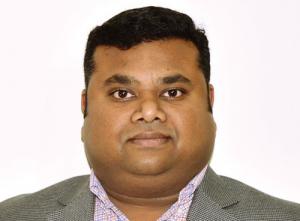Senior Technical Leader
Baskar Vairamohan is Senior Technical Leader at the Electric Power Research Institute.
Steve Mitnick is Editor-in-Chief of Public Utilities Fortnightly and author of the book “Lines Down: How We Pay, Use, Value Grid Electricity Amid the Storm.”
Electric Power Research Institute Senior Technical Leader Baskar Vairamohan explains how industrial customers can employ efficient electrification to improve efficiency and productivity.

PUF's Steve Mitnick: What do you do here?
Baskar Vairamohan: I am a senior technical leader and help run our program called Electrification for Customer Productivity. We identify opportunities for end-use commercial and industrial customers.
Currently they may be using various technologies, mostly fossil fuel-based. We identify an equivalent electric technology that can increase their productivity, worker safety, product quality, and reduce emissions.
PUF's Steve Mitnick: How do you prioritize applications and technologies?
Baskar Vairamohan: We see process heating technologies as relatively low-hanging fruit. Process heating is one of the major energy-consuming areas within industrial processes. Many different industries use process heating: automotive, bottle manufacturing, and aerospace to name a few.
From Pepsi or Coke cans to water bottles, every product that we come across uses heating. That heating could be done more effectively with electricity than with fossil fuel.
PUF's Steve Mitnick: You're saying that it's more efficient?
Baskar Vairamohan: In many cases, yes. When it comes to process heating, electric infrared technology can be used where natural gas is used today.
Here's an example. Currently, if you want to cure and dry paint on a product, it goes through an oven, heated by natural gas burners. The heat cures the paint. It's inefficient because the medium of heat transfer is air.
When you use infrared technology, it uses electromagnetic waveforms to heat the surface of the object directly, not the air around the object. A good example of infrared is our sun. Sunlight is a natural source of infrared. Another common infrared source is the toaster oven. The coils become red-hot. But it's not the coils that heat the bread.
It's the infrared emissions that heat the bread.
PUF's Steve Mitnick: What other technologies are you working with?
Baskar Vairamohan: Ultraviolet curing is another technology that does not use thermal energy. One of the beer can manufacturers was using a traditional oven. When they switched to an ultraviolet oven it increased productivity by forty-three percent, going from fourteen hundred cans-per-minute to two thousand cans-per-minute.
PUF's Steve Mitnick: Where else does electrification provide benefits?
Baskar Vairamohan: Airports. Next time you are on an airplane at the gate look out the window.
You'll see baggage tractors and airplane pushers. Usually those machines have diesel or gasoline engines. The workers leave them idling so they can be moved when necessary. They don't want to turn them off and on.
With electric versions, the moment you get off the machine, it shuts off automatically. Likewise, it can turn on instantly when needed. That's another example where we can add more sophisticated electric technologies.
PUF's Steve Mitnick: Why don't the airports switch?
Baskar Vairamohan: They are switching. We have done assessments of several major airports, accounting for benefits, not just to the airports and airline carriers, but also the customers, the nearby community, and to society.



